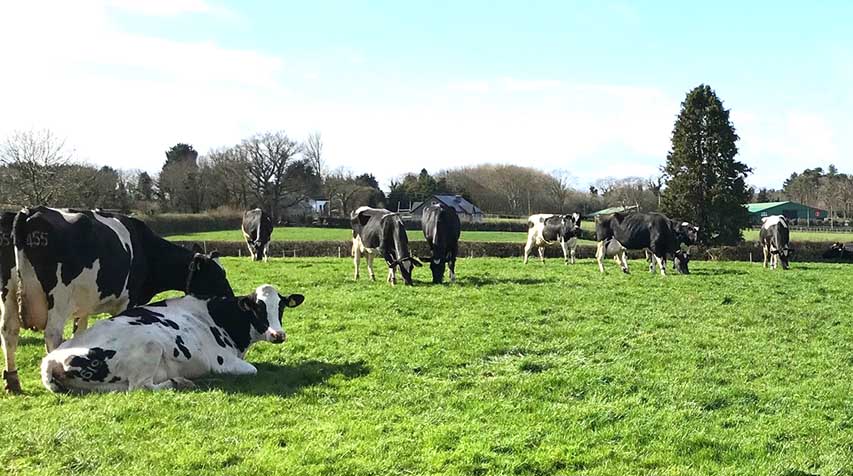How to get livestock to reduce ammonia emissions
Report by Martin Kirk, CAFRE Technologist.
Extended grazing
“Extending the grazing season for livestock is an effective method of reducing ammonia emissions” said Martin. “Ammonia gas, a localised pollutant containing nitrogen and hydrogen, is produced when urea, in urine, and the enzyme urease, in faeces, mix.
“When animals are out in the field, there rarely urinate and dung in the same place.
“Therefore, when grazing animals urinate and it doesn’t mix with faeces, there are reduced opportunities for the urease enzyme to breakdown the urea producing ammonia.
“Whilst urease is naturally present in the soil, it is at a much lower level than faeces and therefore the associated ammonia emissions are reduced”.

The 2020 ammonia inventory for Northern Ireland calculates that 7% of NI ammonia emissions can be attributed to grazing livestock, while 61% of ammonia emissions are associated with the management, storage and spreading of manures.
Extending the grazing season also reduces the volumes of slurry collected, stored and spread on farm.
Martin Kirk added: “Of course, this strategy will be dependent on a number of factors such as weather conditions, soil type and farm infrastructure.
“In wet years, and in wetter regions of Northern Ireland, extending the grazing season will prove more difficult.
“Lighter, sandier soils will dry out, and remain dryer for longer compared to clay and peat soils. Improved soil conditions will allow stock to graze earlier in spring and remain grazing longer in the autumn.
“Irrespective of land type and weather conditions, an improved grazing infrastructure will allow animals to access forage.
“This can be done while minimising the amount of damage to the grazing platform.
“A system of laneways and tracks, with multiple access and exit points to fields/paddocks, with multiple water sources and the use of electric fences will aid the farmers ability to be flexible in their approach to grazing during the shoulders of the grazing season.”
Targeted crude protein diets
“Every 1% reduction in dietary crude protein is associated with a 5-15% reduction in ammonia emissions.
“In its simplest terms, if there is less nitrogen going into the animal, less nitrogen is excreted by the animal. The reduction in nitrogen excreted lessens the amount available for ammonia generation.
“Reducing dietary crude protein will also result in reducing the ration cost. Targeting dietary crude protein, to match animal performance makes sense as the animal’s ability to utilise protein is based on its genetic potential for feed conversion efficiency.
“There are also opportunities for farmers to use locally grown protein sources, substituting imported sources. T
“his should reduce feed costs, increase farm profitability and improve the circular economy within Northern Ireland. Northern Ireland is almost totally dependent on imported soya and other proteins for the manufacture of animal feed.
“Protein crops can aid in ammonia reduction as it will contribute to a reduction in fertiliser use.”
Genetic selection
Martin Kird said: “Genetic selection can aid in ammonia reduction through the selection of animals with improved genetic merit for the reduction of nitrogen excreted per kilo of milk or meat produced; their Feed Conversion Efficiency (FCE).
“Feed Conversion Efficiency has been a long-standing approach to genetic selection within the pig and poultry sectors, which has resulted in significant advancements in reducing feed input while maintaining levels of productivity.
“A Ruminant Genetics Programme is currently being developed under Future Agricultural Policy, whereby farmers would provide data to support the provision of animal and herd performance indicators. This information would help farmers identify and breed the most efficient and environmentally sustainable animals.
“Selection indices, within cattle, are available to estimate the feed efficiency benefit to both the farmers “bottom-line” and the environment.
“In addition, these indices are also identifying animals that will last longer, have improved productivity and improved fertility.”
DAERA Draft Ammonia Strategy Consultation
The Department of Agriculture, Environment and Rural Affairs (DAERA) has launched a consultation on its draft Ammonia Strategy and is keen for anyone with an interest to participate and provide their views.
This public consultation is open for a period of 8 weeks until 23:59, 3 March 2023. We welcome as many views as possible from all interested organisations and individuals.
Two remaining public information events have been organised at CAFRE
Greenmount Campus on 13th February and CAFRE Loughry Campus on 15th February.
Each meeting will commence at 7.30pm and last approximately one hour.
To reserve your place at a meeting please register through Eventbrite at:
www.cafre.ac.uk/draft-ammonia-strategy.
For further information including details of how to respond go to:


























